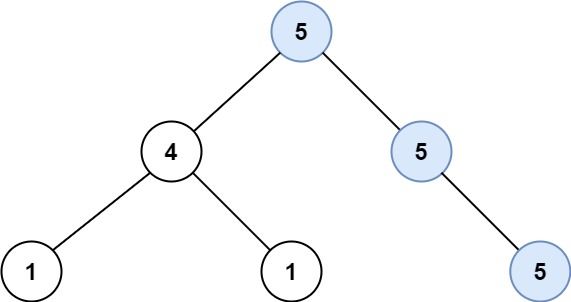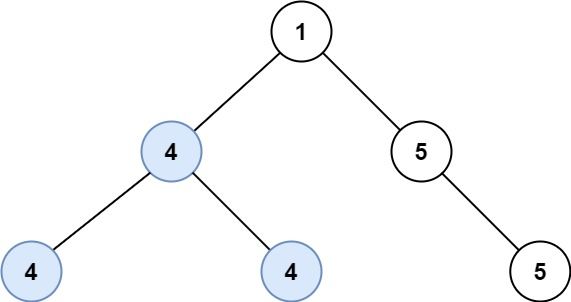| comments | difficulty | edit_url | tags | |||
|---|---|---|---|---|---|---|
true |
中等 |
|
给定一个二叉树的 root ,返回 最长的路径的长度 ,这个路径中的 每个节点具有相同值 。 这条路径可以经过也可以不经过根节点。
两个节点之间的路径长度 由它们之间的边数表示。
示例 1:
输入:root = [5,4,5,1,1,5] 输出:2
示例 2:
输入:root = [1,4,5,4,4,5] 输出:2
提示:
- 树的节点数的范围是
[0, 104] -1000 <= Node.val <= 1000- 树的深度将不超过
1000
我们设计一个函数
在
如果
在递归调用完左右孩子之后,我们更新答案为
最后,$\textit{dfs}(root)$ 函数返回以
在主函数中,我们调用
时间复杂度
# Definition for a binary tree node.
# class TreeNode:
# def __init__(self, val=0, left=None, right=None):
# self.val = val
# self.left = left
# self.right = right
class Solution:
def longestUnivaluePath(self, root: Optional[TreeNode]) -> int:
def dfs(root: Optional[TreeNode]) -> int:
if root is None:
return 0
l, r = dfs(root.left), dfs(root.right)
l = l + 1 if root.left and root.left.val == root.val else 0
r = r + 1 if root.right and root.right.val == root.val else 0
nonlocal ans
ans = max(ans, l + r)
return max(l, r)
ans = 0
dfs(root)
return ans/**
* Definition for a binary tree node.
* public class TreeNode {
* int val;
* TreeNode left;
* TreeNode right;
* TreeNode() {}
* TreeNode(int val) { this.val = val; }
* TreeNode(int val, TreeNode left, TreeNode right) {
* this.val = val;
* this.left = left;
* this.right = right;
* }
* }
*/
class Solution {
private int ans;
public int longestUnivaluePath(TreeNode root) {
dfs(root);
return ans;
}
private int dfs(TreeNode root) {
if (root == null) {
return 0;
}
int l = dfs(root.left);
int r = dfs(root.right);
l = root.left != null && root.left.val == root.val ? l + 1 : 0;
r = root.right != null && root.right.val == root.val ? r + 1 : 0;
ans = Math.max(ans, l + r);
return Math.max(l, r);
}
}/**
* Definition for a binary tree node.
* struct TreeNode {
* int val;
* TreeNode *left;
* TreeNode *right;
* TreeNode() : val(0), left(nullptr), right(nullptr) {}
* TreeNode(int x) : val(x), left(nullptr), right(nullptr) {}
* TreeNode(int x, TreeNode *left, TreeNode *right) : val(x), left(left), right(right) {}
* };
*/
class Solution {
public:
int longestUnivaluePath(TreeNode* root) {
int ans = 0;
auto dfs = [&](this auto&& dfs, TreeNode* root) -> int {
if (!root) {
return 0;
}
int l = dfs(root->left);
int r = dfs(root->right);
l = root->left && root->left->val == root->val ? l + 1 : 0;
r = root->right && root->right->val == root->val ? r + 1 : 0;
ans = max(ans, l + r);
return max(l, r);
};
dfs(root);
return ans;
}
};/**
* Definition for a binary tree node.
* type TreeNode struct {
* Val int
* Left *TreeNode
* Right *TreeNode
* }
*/
func longestUnivaluePath(root *TreeNode) (ans int) {
var dfs func(*TreeNode) int
dfs = func(root *TreeNode) int {
if root == nil {
return 0
}
l, r := dfs(root.Left), dfs(root.Right)
if root.Left != nil && root.Left.Val == root.Val {
l++
} else {
l = 0
}
if root.Right != nil && root.Right.Val == root.Val {
r++
} else {
r = 0
}
ans = max(ans, l+r)
return max(l, r)
}
dfs(root)
return
}/**
* Definition for a binary tree node.
* class TreeNode {
* val: number
* left: TreeNode | null
* right: TreeNode | null
* constructor(val?: number, left?: TreeNode | null, right?: TreeNode | null) {
* this.val = (val===undefined ? 0 : val)
* this.left = (left===undefined ? null : left)
* this.right = (right===undefined ? null : right)
* }
* }
*/
function longestUnivaluePath(root: TreeNode | null): number {
let ans: number = 0;
const dfs = (root: TreeNode | null): number => {
if (!root) {
return 0;
}
let [l, r] = [dfs(root.left), dfs(root.right)];
l = root.left && root.left.val === root.val ? l + 1 : 0;
r = root.right && root.right.val === root.val ? r + 1 : 0;
ans = Math.max(ans, l + r);
return Math.max(l, r);
};
dfs(root);
return ans;
}// Definition for a binary tree node.
// #[derive(Debug, PartialEq, Eq)]
// pub struct TreeNode {
// pub val: i32,
// pub left: Option<Rc<RefCell<TreeNode>>>,
// pub right: Option<Rc<RefCell<TreeNode>>>,
// }
//
// impl TreeNode {
// #[inline]
// pub fn new(val: i32) -> Self {
// TreeNode {
// val,
// left: None,
// right: None
// }
// }
// }
use std::cell::RefCell;
use std::rc::Rc;
impl Solution {
fn dfs(root: &Option<Rc<RefCell<TreeNode>>>, target: i32, ans: &mut i32) -> i32 {
if root.is_none() {
return 0;
}
let root = root.as_ref().unwrap().borrow();
let left = Self::dfs(&root.left, root.val, ans);
let right = Self::dfs(&root.right, root.val, ans);
*ans = (*ans).max(left + right);
if root.val == target {
return left.max(right) + 1;
}
0
}
pub fn longest_univalue_path(root: Option<Rc<RefCell<TreeNode>>>) -> i32 {
if root.is_none() {
return 0;
}
let mut ans = 0;
Self::dfs(&root, root.as_ref().unwrap().borrow().val, &mut ans);
ans
}
}/**
* Definition for a binary tree node.
* function TreeNode(val, left, right) {
* this.val = (val===undefined ? 0 : val)
* this.left = (left===undefined ? null : left)
* this.right = (right===undefined ? null : right)
* }
*/
/**
* @param {TreeNode} root
* @return {number}
*/
var longestUnivaluePath = function (root) {
let ans = 0;
const dfs = root => {
if (!root) {
return 0;
}
let [l, r] = [dfs(root.left), dfs(root.right)];
l = root.left && root.left.val === root.val ? l + 1 : 0;
r = root.right && root.right.val === root.val ? r + 1 : 0;
ans = Math.max(ans, l + r);
return Math.max(l, r);
};
dfs(root);
return ans;
};/**
* Definition for a binary tree node.
* struct TreeNode {
* int val;
* struct TreeNode *left;
* struct TreeNode *right;
* };
*/
#define max(a, b) (((a) > (b)) ? (a) : (b))
int dfs(struct TreeNode* root, int* ans) {
if (!root) {
return 0;
}
int l = dfs(root->left, ans);
int r = dfs(root->right, ans);
l = root->left && root->left->val == root->val ? l + 1 : 0;
r = root->right && root->right->val == root->val ? r + 1 : 0;
*ans = max(*ans, l + r);
return max(l, r);
}
int longestUnivaluePath(struct TreeNode* root) {
int ans = 0;
dfs(root, &ans);
return ans;
}
